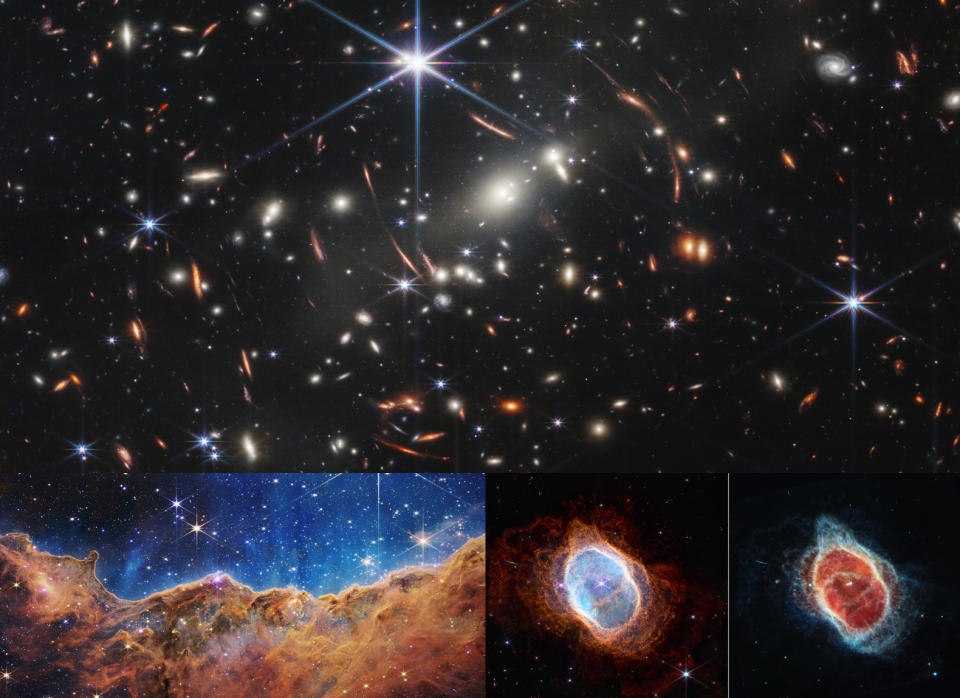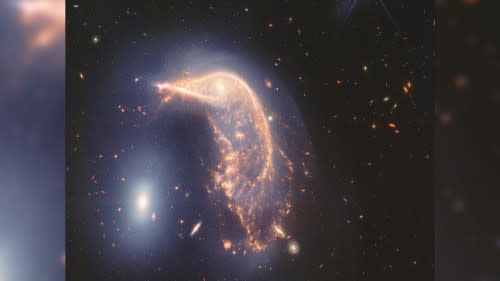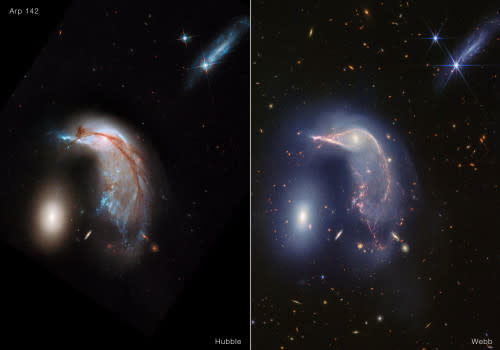Merging galaxies look like 'Penguin and Egg' in new image from JWST

- Oops!Something went wrong.Please try again later.
To mark the second anniversary of our first official look at science images from the James Webb Space Telescope, NASA has released a new view from the telescope showing Arp 142, a pair of merging galaxies nicknamed the Penguin and the Egg.
On July 12, 2022, after a little over seven months of anticipation since its launch in December 2021, we were finally able to see the first release of science images from JWST.

This collage contains just a sample of the first science images from Webb, released on July 12, 2022, showing galaxy supercluster SMACS 0723 (top), the Carina Nebula (bottom left), and two views of the Southern Ring Nebula in different wavelengths of infrared light (bottom right). (NASA, ESA, CSA, STScI)
READ MORE: Webb's first images spark awe and wonder about the universe
In celebration of two years of science from Webb, a new set of images has been released. In this case, though, the focus was one target in particular.
Located around 400 million light years away from us are two galaxies, named NGC 2936 and NGC 2937. Together, they are known as Arp 142, as the pair is the 142nd entry catalogued in Caltech astronomer Halton Arp's Atlas of Peculiar Galaxies.
And peculiar, they are!

Arp 142 appears in a new infrared view from the James Webb Space Telescope. These two interacting galaxies are in the middle of a lengthy process of merging together into one. (NASA, ESA, CSA, STScI)
For billions of years, these two galaxies had been drawing ever closer to one another. Somewhere between 25 and 75 million years ago, they completed their first pass, with their mutual gravitational attraction sculpting them into the shape we see now.
According to NASA: "Before their first approach, the Penguin held the shape of a spiral. Today, its galactic center gleams like an eye, its unwound arms now shaping a beak, head, backbone, and fanned-out tail. Like all spiral galaxies, the Penguin is still very rich in gas and dust. The galaxies' 'dance' gravitationally pulled on the Penguin's thinner areas of gas and dust, causing them to crash in waves and form stars. Look for those areas in two places: what looks like a fish in its 'beak' and the 'feathers' in its 'tail.' Surrounding these newer stars is smoke-like material that includes carbon-containing molecules, known as polycyclic aromatic hydrocarbons, which Webb is exceptional at detecting. Dust, seen as fainter, deeper orange arcs also swoops from its beak to tail feathers."
"In contrast, the Egg's compact shape remains largely unchanged. As an elliptical galaxy, it is filled with aging stars, and has a lot less gas and dust that can be pulled away to form new stars. If both were spiral galaxies, each would end the first 'twist' with new star formation and twirling curls, known as tidal tails. Another reason for the Egg’s undisturbed appearance: These galaxies have approximately the same mass or heft, which is why the smaller-looking elliptical wasn't consumed or distorted by the Penguin."
Our best look at Arp 142 before this came from the Hubble Space Telescope.

Hubble's view of Arp 142 from June 22, 2012 (left) is shown next to Webb's new look, captured on May 6, 2024 (right). (NASA, ESA, CSA, STScI)
Hubble showed us the intricate lanes of dust embedded in the Penguin (NGC 2396), as well as the bright halo of dust and gas surrounding the Egg (NGC 2397). However, Webb peers straight through all of that obscuring matter to reveal the billions of stars contained in both galaxies.
Additionally, while Hubble gave us hints of what is in the background of this region of space, Webb's view shows us so much more! Nearly every splotch or point of light outside of the Penguin and Egg is a galaxy unto itself, containing billions of stars of its own!
"In just two years, Webb has transformed our view of the universe, enabling the kind of world-class science that drove NASA to make this mission a reality," Mark Clampin, director of the Astrophysics Division at NASA Headquarters, said in the press release. "Webb is providing insights into longstanding mysteries about the early universe and ushering in a new era of studying distant worlds, while returning images that inspire people around the world and posing exciting new questions to answer. It has never been more possible to explore every facet of the universe."

